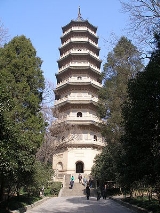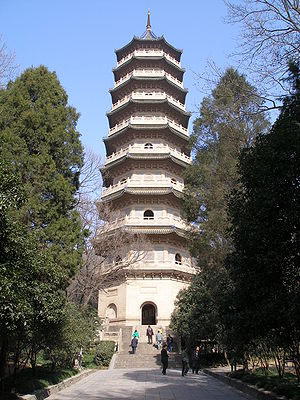
Linggu Temple
Encyclopedia
Linggu Temple is a Buddhist temple in Nanjing
, Jiangsu
, China
. The temple was described as 'the best Buddhist temple in the world'. It was now surrounded by a large park.

was first built in 515 under the reign of the Liang Dynasty
(502-557). It used to lie at the northeast foot of Mount Zhongshan, i.e. where Ming Xiaoling Mausoleum
now locates, since Emperor Zhu Yuanzhang
chose the place to be his mausoleum and then the temple was moved to the present place. The temple was named by Emperor Zhu Yuanzhang himself. It used to be large and covered an area of over 300,000 square metres. Later it was destroyed in warfare under the reign of Emperor Xianfeng
and rebuilt under the reign of Emperor Tongzhi
in the Qing Dynasty
(1644-1911). In the temple, except for Buddhas
and Bodhisattva
s, Monk Xuanzang
and his relic were enshrined and worshiped.
Wuliang Hall, or Beamless Hall, was constructed in 1381, and is 22-meters-high and 53.8-meter- wide. The hall enjoys high reputation for its special architectural techniques
. It has three archways on the front and rear sides respectively. The structure was built with bricks from the bottom to the top entirely, without a piece of wood or a single nail. Thus it was called Wuliang Hall, since Wuliang means beamless. It happens that the hall originally enshrined Amitayus (Buddha of Infinite Life) whose Chinese name pronounces the same with Wuliang. Later in 1928, the hall was turned into the memorial hall of soldiers who lost their lives in the War of Northern Expedition (1926-1927). More than 30,000 soldiers were enshrined.
Linggu Pagoda was built in 1929 as a sign of remembrance for those soldiers. The 9 stories pagoda
stands 60.5 meters high. Speeches made by Dr. Sun Yat-Sen
and epigraphs of Chiang Kai-Shek
were inscribed on the tower.
In the temple, there is also a Three Superb Tablet, on which a painting of Monk Baozhi, painted by Wu Daozi
, a famous painter, a memorial poem written by Li Bai
, the most outstanding poet, and calligraphy written by Yan Zhenqing
, a well-known calligrapher in the Tang Dynasty
(618-907) were inscribed. Since the three were all superb masters in their own field in the Tang dynasty, the tablet was considered Three Superb Tablet. Unfortunately, the original tablet was broken in warfare, the present one is a duplicate under the reign of Emperor Qianlong
in the Qing dynasty.
Nanjing
' is the capital of Jiangsu province in China and has a prominent place in Chinese history and culture, having been the capital of China on several occasions...
, Jiangsu
Jiangsu
' is a province of the People's Republic of China, located along the east coast of the country. The name comes from jiang, short for the city of Jiangning , and su, for the city of Suzhou. The abbreviation for this province is "苏" , the second character of its name...
, China
China
Chinese civilization may refer to:* China for more general discussion of the country.* Chinese culture* Greater China, the transnational community of ethnic Chinese.* History of China* Sinosphere, the area historically affected by Chinese culture...
. The temple was described as 'the best Buddhist temple in the world'. It was now surrounded by a large park.

History
The templeTemple
A temple is a structure reserved for religious or spiritual activities, such as prayer and sacrifice, or analogous rites. A templum constituted a sacred precinct as defined by a priest, or augur. It has the same root as the word "template," a plan in preparation of the building that was marked out...
was first built in 515 under the reign of the Liang Dynasty
Liang Dynasty
The Liang Dynasty , also known as the Southern Liang Dynasty , was the third of the Southern dynasties in China and was followed by the Chen Dynasty...
(502-557). It used to lie at the northeast foot of Mount Zhongshan, i.e. where Ming Xiaoling Mausoleum
Ming Xiaoling Mausoleum
The Ming Xiaoling Mausoleum is the tomb of the Hongwu Emperor, the founder of the Ming Dynasty. It lies at the southern foot of Purple Mountain , located east of the historical center of Nanjing, China...
now locates, since Emperor Zhu Yuanzhang
Hongwu Emperor
The Hongwu Emperor , known variably by his given name Zhu Yuanzhang and by his temple name Taizu of Ming , was the founder and first emperor of the Ming Dynasty of China...
chose the place to be his mausoleum and then the temple was moved to the present place. The temple was named by Emperor Zhu Yuanzhang himself. It used to be large and covered an area of over 300,000 square metres. Later it was destroyed in warfare under the reign of Emperor Xianfeng
Xianfeng Emperor
The Xianfeng Emperor , born Aisin-Gioro I Ju, was the ninth Emperor of the Qing Dynasty, and the seventh Qing emperor to rule over China, from 1850 to 1861.-Family and his early years:...
and rebuilt under the reign of Emperor Tongzhi
Tongzhi Emperor
The Tongzhi Emperor , born Aisin-Gioro Dzai Šun, was the tenth emperor of the Manchu-led Qing Dynasty, and the eighth Qing emperor to rule over China, from 1861 to 1875. His reign, which effectively lasted through his adolescence, was largely overshadowed by the rule of his mother, the Empress...
in the Qing Dynasty
Qing Dynasty
The Qing Dynasty was the last dynasty of China, ruling from 1644 to 1912 with a brief, abortive restoration in 1917. It was preceded by the Ming Dynasty and followed by the Republic of China....
(1644-1911). In the temple, except for Buddhas
Buddhahood
In Buddhism, buddhahood is the state of perfect enlightenment attained by a buddha .In Buddhism, the term buddha usually refers to one who has become enlightened...
and Bodhisattva
Bodhisattva
In Buddhism, a bodhisattva is either an enlightened existence or an enlightenment-being or, given the variant Sanskrit spelling satva rather than sattva, "heroic-minded one for enlightenment ." The Pali term has sometimes been translated as "wisdom-being," although in modern publications, and...
s, Monk Xuanzang
Xuanzang
Xuanzang was a famous Chinese Buddhist monk, scholar, traveler, and translator who described the interaction between China and India in the early Tang period...
and his relic were enshrined and worshiped.
Wuliang Hall, or Beamless Hall, was constructed in 1381, and is 22-meters-high and 53.8-meter- wide. The hall enjoys high reputation for its special architectural techniques
Architecture
Architecture is both the process and product of planning, designing and construction. Architectural works, in the material form of buildings, are often perceived as cultural and political symbols and as works of art...
. It has three archways on the front and rear sides respectively. The structure was built with bricks from the bottom to the top entirely, without a piece of wood or a single nail. Thus it was called Wuliang Hall, since Wuliang means beamless. It happens that the hall originally enshrined Amitayus (Buddha of Infinite Life) whose Chinese name pronounces the same with Wuliang. Later in 1928, the hall was turned into the memorial hall of soldiers who lost their lives in the War of Northern Expedition (1926-1927). More than 30,000 soldiers were enshrined.
Linggu Pagoda was built in 1929 as a sign of remembrance for those soldiers. The 9 stories pagoda
Pagoda
A pagoda is the general term in the English language for a tiered tower with multiple eaves common in Nepal, India, China, Japan, Korea, Vietnam and other parts of Asia. Some pagodas are used as Taoist houses of worship. Most pagodas were built to have a religious function, most commonly Buddhist,...
stands 60.5 meters high. Speeches made by Dr. Sun Yat-Sen
Sun Yat-sen
Sun Yat-sen was a Chinese doctor, revolutionary and political leader. As the foremost pioneer of Nationalist China, Sun is frequently referred to as the "Father of the Nation" , a view agreed upon by both the People's Republic of China and the Republic of China...
and epigraphs of Chiang Kai-Shek
Chiang Kai-shek
Chiang Kai-shek was a political and military leader of 20th century China. He is known as Jiǎng Jièshí or Jiǎng Zhōngzhèng in Mandarin....
were inscribed on the tower.
In the temple, there is also a Three Superb Tablet, on which a painting of Monk Baozhi, painted by Wu Daozi
Wu Daozi
Wu Daozi was a Chinese artist of the Tang Dynasty, famous for initiating new myths in his artwork.The myth follows the creation by Wu Daozi of a mural commissioned by Emperor Xuanzong of Tang China...
, a famous painter, a memorial poem written by Li Bai
Li Bai
Li Bai , also known in the West by various other transliterations, especially Li Po, was a major Chinese poet of the Tang dynasty poetry period. He has been regarded as one of the greatest poets in China's Tang period, which is often called China's "golden age" of poetry. Around a thousand existing...
, the most outstanding poet, and calligraphy written by Yan Zhenqing
Yan Zhenqing
Yan Zhenqing was a leading Chinese calligrapher and a loyal governor of the Tang Dynasty. His artistic accomplishment in Chinese calligraphy parallels the greatest master calligraphers throughout the history, and his regular script style, Yan, is often imitated.-Early life:Yan Zhenqing was born...
, a well-known calligrapher in the Tang Dynasty
Tang Dynasty
The Tang Dynasty was an imperial dynasty of China preceded by the Sui Dynasty and followed by the Five Dynasties and Ten Kingdoms Period. It was founded by the Li family, who seized power during the decline and collapse of the Sui Empire...
(618-907) were inscribed. Since the three were all superb masters in their own field in the Tang dynasty, the tablet was considered Three Superb Tablet. Unfortunately, the original tablet was broken in warfare, the present one is a duplicate under the reign of Emperor Qianlong
Qianlong Emperor
The Qianlong Emperor was the sixth emperor of the Manchu-led Qing Dynasty, and the fourth Qing emperor to rule over China proper. The fourth son of the Yongzheng Emperor, he reigned officially from 11 October 1735 to 8 February 1796...
in the Qing dynasty.

